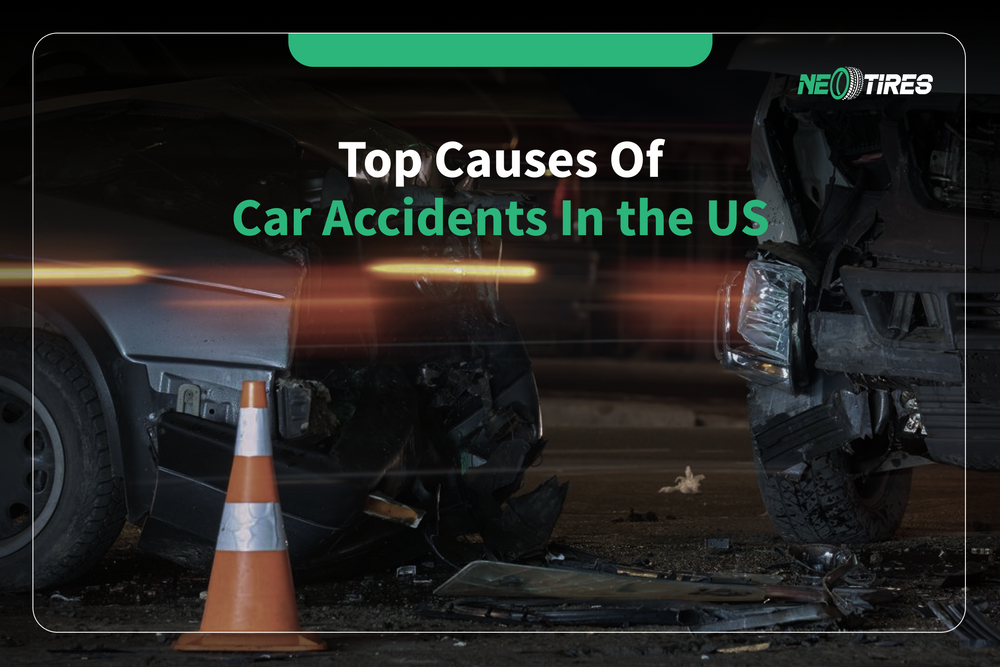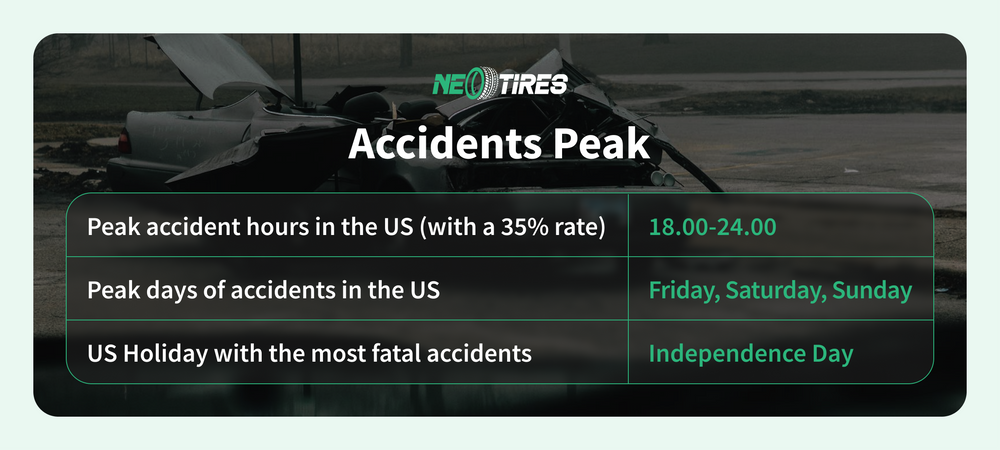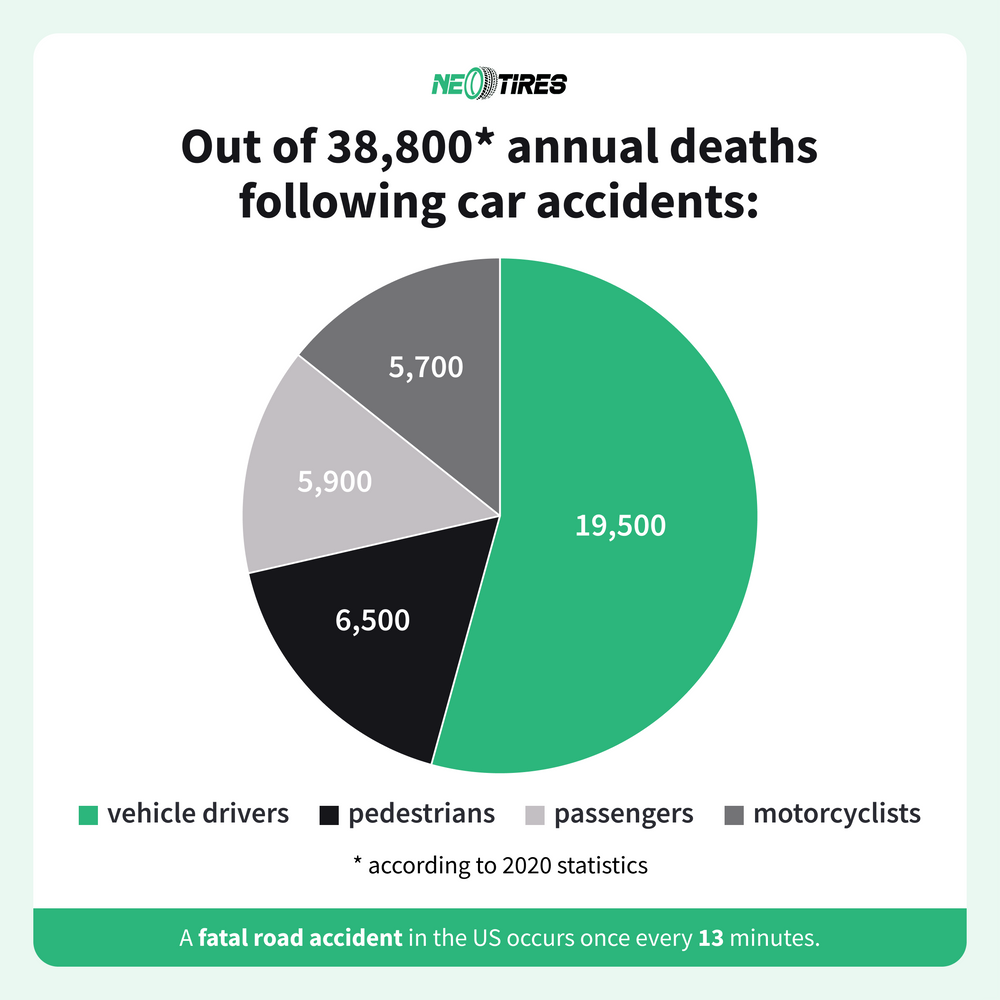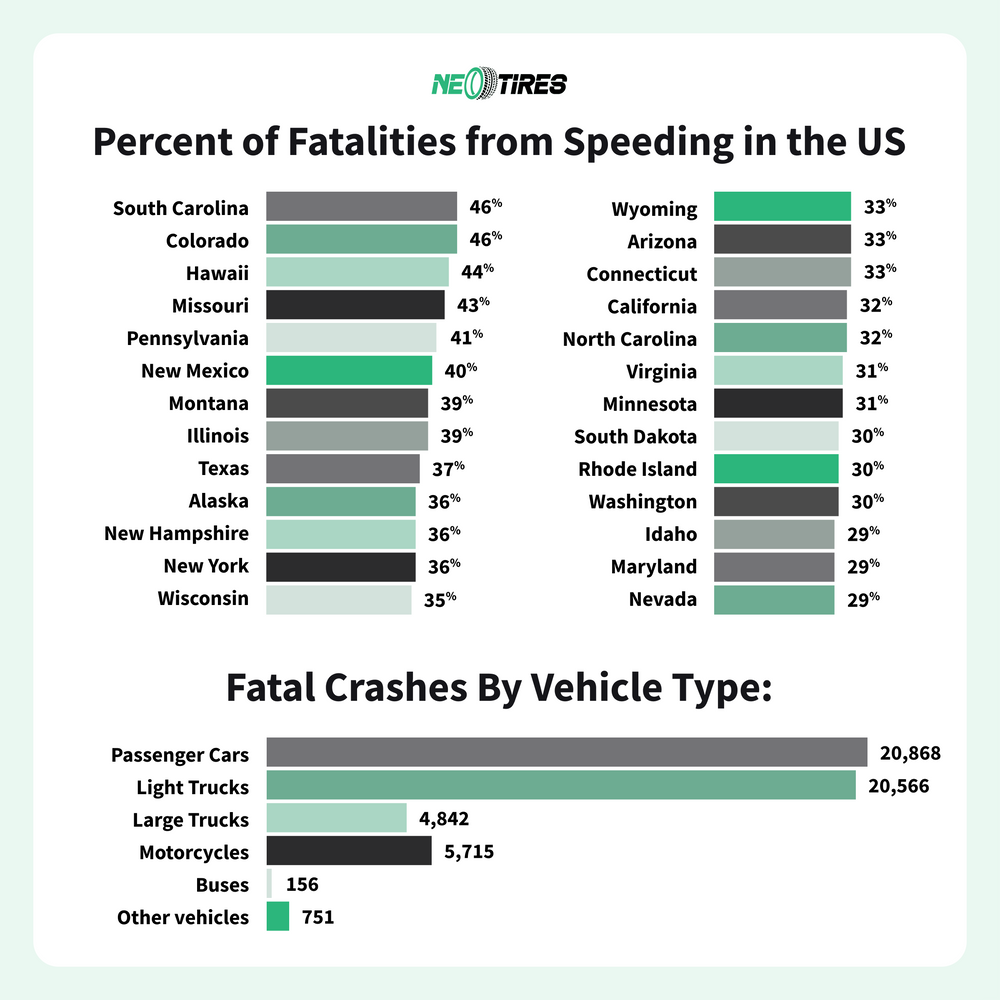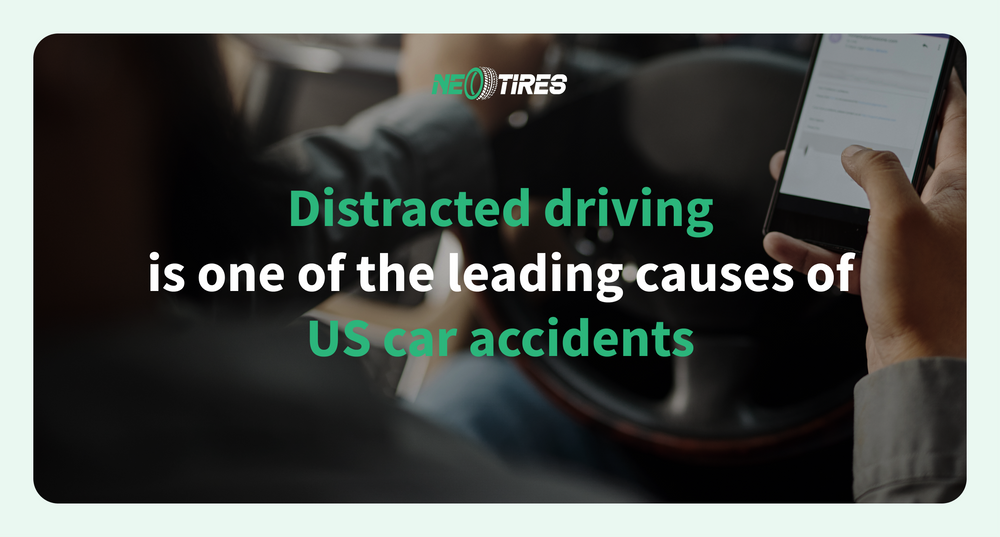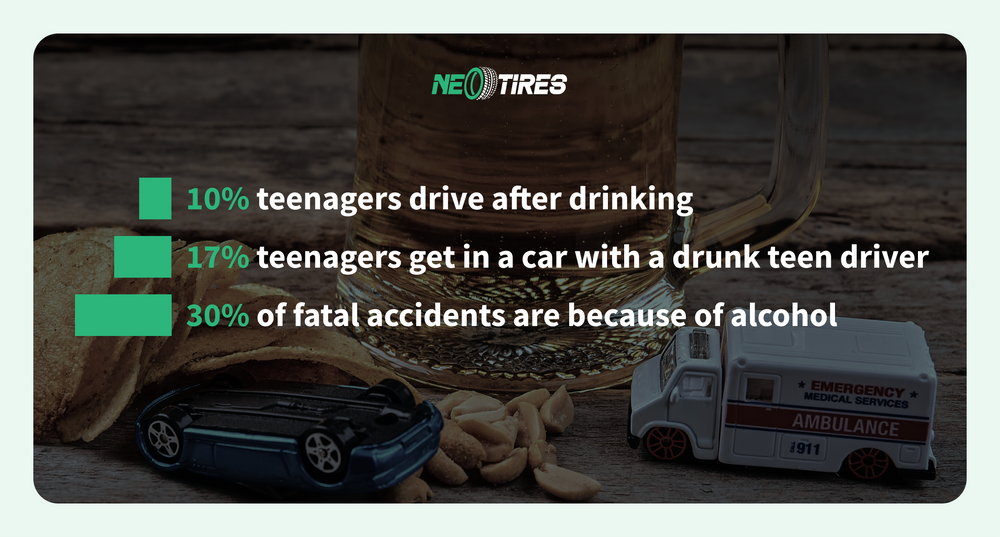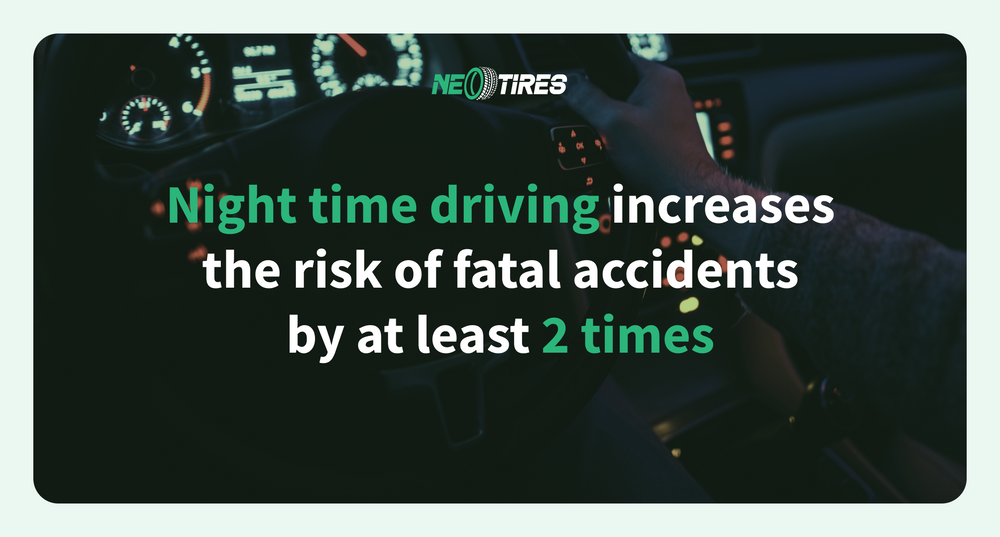Regardless of the severity degree, car accidents are always a hassle for those involved. From small vehicle defects to drastic consequences for drivers and passengers, accidents end up endangering the safety and health of more than 5 million people in the US annually.
NeoTires experts researched this topic to identify the most frequent causes of car accidents in the U.S. By knowing the causes of accidents, drivers can potentially prevent them and ensure safer driving for themselves and their passengers.
US Car Accidents In Numbers
According to official statistics, driving time is one of the influencing factors in car accidents. The period with the highest probability of accidents is between 18.00 and 24.00, with an accident rate of 35%.
Weekends record a higher number of accidents than weekdays. The most serious collisions with fatal consequences occur mainly on Fridays, Saturdays, and Sundays.
Accidents are more common on holidays (Christmas, for example) because of heavier traffic. Of all the official holidays of the year, Independence Day has the highest number of fatal accidents in the U.S.
Who Suffers the Most in Road Accidents?
The highest number of fatalities in car accidents is recorded among vehicle drivers (19,500 out of 38,800 as per 2020 year statistics). Pedestrians are the most affected victims after drivers (6,500 deaths in 2020). Passengers are in the 3rd place of the most affected participants in accidents with a death toll of 5,900 in 2020.
The number of motorcyclists involved in fatal accidents is approximately 5,700 (as per 2020 statistics) while approximately 1,200 people lose their lives in road accidents for miscellaneous reasons. At the moment, a fatal road accident in the US occurs every 13 minutes.
How Many Deaths Are Caused by Speeding in the US?
29% of traffic fatalities in the U.S. are caused by speeding, as per 2022 year NHTSA data, making speeding a major cause of roadway deaths. Most fatalities occur on non-interstate roads rather than highways. See below the detailed percentage of fatalities from speeding per state in the U.S.:
It is worth mentioning that passenger vehicles are the most frequently involved in severe car accidents. Light trucks are involved almost as frequently as passenger vehicles with a difference of about 500 units annually. Buses are the least involved in collisions, registering only up to 200 accidents annually.
Top Causes Of Car Accidents in the US
Top causes of car accidents in the U.S. include: speeding, distracted driving, drunk driving, overhasty driving, road conditions (wet, snowy, icy roads), ignoring red lights, ignoring stop signs, teenage driving, driving at tight, unsafe lane changes, tire blowouts, and street racing.
Speeding
Ignoring speed limits for a specific road condition is a major contributor to car crashes. Driving faster reduces the driver's ability to react promptly to road hazards, amplifies impact severity, and increases braking distance. Speeding was the leading cause of 26% of traffic fatalities in the U.S. in 2020, as per NHTSA.
Distracted Driving
Distracted driving refers to activities that take the driver's attention away from the road. This includes talking on the phone, listening to loud music, texting, eating, or talking to passengers. Distracted driving diverts focus away from traffic signs, critical crossroads/roundabouts, or other important maneuvers while driving. Every day, distracted driving causes more than 1,000 injuries and approximately nine deaths in the U.S., according to the CDC.
Drunk Driving
Driving in a drunk condition distorts reality and significantly impairs a driver's ability to focus and handle the vehicle safely. Alcohol and drugs slow down the reaction time and judgment, as well as reduce the driver's motor skills. Drunk driving is the cause of nearly 30% of traffic fatalities in the U.S. every year, meaning about 1,000 deaths, as estimated by NHTSA.
Overhasty Driving
Overhasty driving refers to impatient driving when the driver rushes to meet deadlines. Such driving is typically accompanied by aggressive behavior and an anxious driving style, such as tailgating, speeding, or changing lanes fast, weaving through traffic. Aggressive driving manners and reckless actions behind the wheel contribute to 56% of fatal crashes in the U.S., as per the AAA Foundation for Traffic Safety.
Weather Conditions (Wet, Snowy, Icy Roads)
Unfavorable weather conditions, such as rain, snow, or ice, make it difficult for drivers to handle the vehicle steadily. Wet roads increase the stopping distance by nearly 50%, contributing to almost 70,000 crashes annually. Icy and snowy roads can impact vehicle traction, especially with tires unsuitable for the season. Drivers need to increase the distance from other cars during poor weather conditions and use suitable tires for the season to reduce the risk of accidents.
Ignoring Red Lights
Ignoring red lights is a dangerous driving behavior leading to side-impact or T-bone car collisions in most cases. Failing to yield at crossroads with red lights on brings about 800 deaths annually, according to the Insurance Institute for Highway Safety.
Ignoring Stop Signs
Ignoring stop signs at crossroads and intersections is a leading factor in thousands of car crashes annually, with a significant number of injuries involved. This driving behavior typically means driving through intersections without yielding the right of way, especially when other drivers don't expect other vehicles to be speeding through.
Teenage Driving
Teens, especially those between the ages of 16 and 19, are nearly three times more likely to be involved in a fatal crash than adults, according to the CDC. This phenomenon is explained by the youngsters' poor driving experience and impulsive behavior. Teenagers adopt risky behaviors behind the wheel and easily engage in distracted driving and speeding, which causes an impressive number of victims among the youth.
Driving At Night
Night driving is a frequent cause of car accidents due to reduced visibility, lack of natural light, which makes it harder to judge distances and obstacles, delayed reaction to road hazards, and increased fatigue. While only 25% of driving takes place at night, nearly 50% of fatalities on the road happen during nighttime, as per the National Safety Council.
Fatigue is a major concern as drowsy driving delays reaction time and impairs decision-making, especially in low visibility conditions. NHTSA reports that most road accidents take place between midnight and early morning.
Unsafe Lane Changes
Changing lanes abruptly leads to rear-end and side-swipe collisions. The risk is typically higher in heavy traffic, at high speed. Car crashes due to abrupt lane changes without signaling other drivers occur mainly in busy urban or highway settings, as reported by IIHS.
Tire Blowouts
A tire blowout is a sudden tire burst with rapid air loss caused by tire wear, underinflation/overinflation, failure to follow tire load and speed ratings, or road obstacles. A blowout causes loss of control over the vehicle, especially at high speed, leading to collisions with other vehicles or roadside barriers. Up to a thousand accidents of medium to serious severity occur annually due to tire blowouts. NHTSA encourages regular tire maintenance and pressure checks to reduce blowout risks.
Street Racing
While not the most common cause of accidents, street racing contributes to hundreds of fatalities annually. This type of driving is characterized by excessive speeding and risky maneuvers that not all drivers can handle.
U.S. Car Accidents: FAQs
What Are The Most Common Causes Of A Vehicle Collision?
The most frequent causes include the following:
- Distracted Driving
- Speeding
- Drunk driving
- Overhasty driving
- Night driving while exhausted
- Adverse weather conditions
- Ignoring red lights/stop signs
- Teenage driving
- Unsafe lane changes
- Tire blowouts
- Race driving
What Is The Single Greatest Factor In Car Accidents?
Human error is the leading cause of car accidents. Most collisions and crashes occur when drivers make reckless decisions, fail to estimate driving risks, become distracted, and ignore speed limits. Other critical mistakes include ignoring tire condition, seatbelt wear, and traffic laws - all of which are decisions that the driver assumes consciously, without taking into account the potential risks and dangers.
Ways to Avoid Car Accidents
- Stay Focused – avoid any distractions behind the wheel;
- Follow Speed Limits – respect legal speed, and adjust for road and weather conditions;
- Keep a safe distance – a three-second gap, at least, between 2 vehicles is recommended to allow for sudden stops;
- Use turn signals – alert about your intentions when changing lanes;
- Obey traffic signs, rules, and laws – stop at red lights, follow all road signs, and yield when necessary;
- Drive defensively – estimate and anticipate other drivers' actions to react safely;
- Avoid prohibited substances – No alcohol, no drugs, or medications that impair judgment;
- Check blind spots – always look over your shoulder before changing lanes to avoid unseen vehicles;
- Adjust driving in bad weather – Slow down, keep a safe distance;
- Keep your vehicle in optimal condition – maintain your vehicle according to the manufacturer's recommendations;
- Use your seatbelt – always wear a seatbelt and insist on passengers to do the same.
- Avoid aggressive driving – don’t engage in road rage behaviors;
- Avoid driving when fatigued – take breaks on long trips and get enough sleep before hitting the road;
- Be cautious at crossroads – Look both ways before crossing, even when you have the right of way;
- Watch for pedestrians and cyclists – Be mindful of crosswalks, bike lanes, and school zones;
- Get the right tires for the driving conditions: the right tires for the weather and road conditions ensure traction, performance, and control.
Need Tires for Safe and Confident Driving?
NeoTires can help you with that. Explore our extensive listing to find the best match for any season and road conditions. Whether you need off-road traction or smooth gliding on highways, we offer top brands at competitive prices.
? Browse our selection now: NeoTires Catalog
? Need expert advice? Contact us, and we'll help you choose the best tires for your vehicle!




